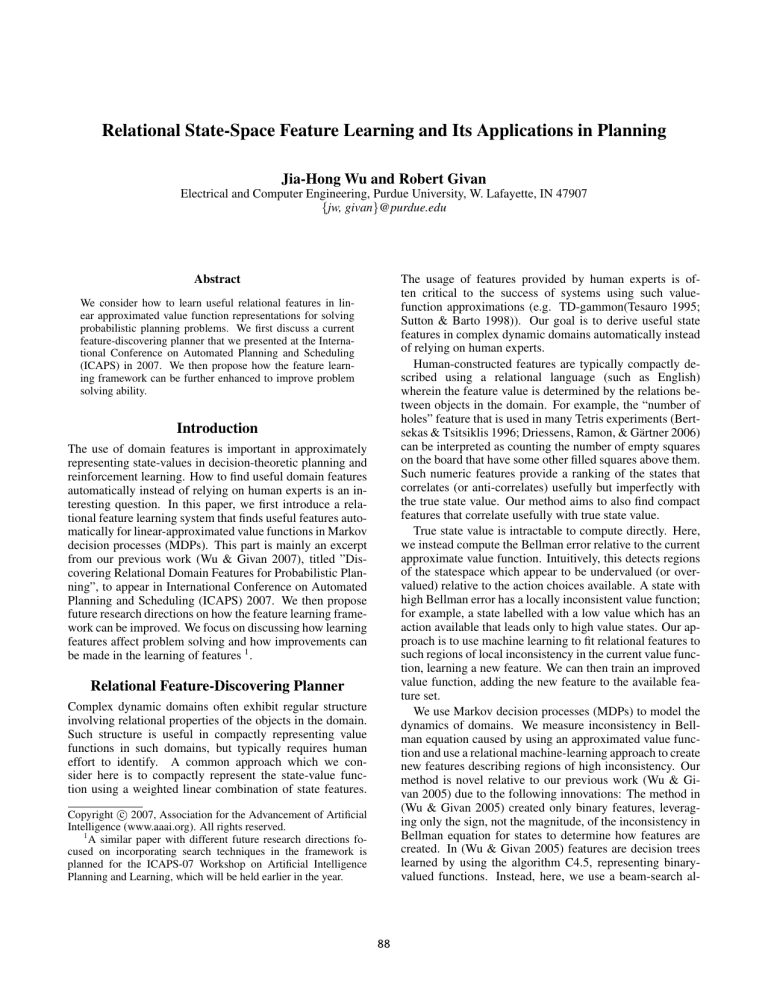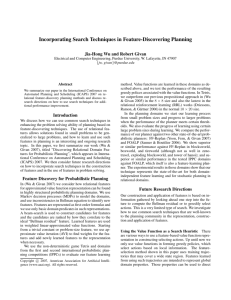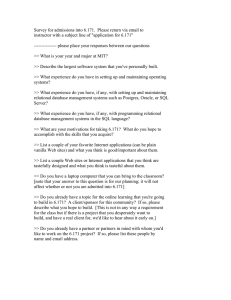
Relational State-Space Feature Learning and Its Applications in Planning
Jia-Hong Wu and Robert Givan
Electrical and Computer Engineering, Purdue University, W. Lafayette, IN 47907
{jw, givan}@purdue.edu
The usage of features provided by human experts is often critical to the success of systems using such valuefunction approximations (e.g. TD-gammon(Tesauro 1995;
Sutton & Barto 1998)). Our goal is to derive useful state
features in complex dynamic domains automatically instead
of relying on human experts.
Human-constructed features are typically compactly described using a relational language (such as English)
wherein the feature value is determined by the relations between objects in the domain. For example, the “number of
holes” feature that is used in many Tetris experiments (Bertsekas & Tsitsiklis 1996; Driessens, Ramon, & Gärtner 2006)
can be interpreted as counting the number of empty squares
on the board that have some other filled squares above them.
Such numeric features provide a ranking of the states that
correlates (or anti-correlates) usefully but imperfectly with
the true state value. Our method aims to also find compact
features that correlate usefully with true state value.
True state value is intractable to compute directly. Here,
we instead compute the Bellman error relative to the current
approximate value function. Intuitively, this detects regions
of the statespace which appear to be undervalued (or overvalued) relative to the action choices available. A state with
high Bellman error has a locally inconsistent value function;
for example, a state labelled with a low value which has an
action available that leads only to high value states. Our approach is to use machine learning to fit relational features to
such regions of local inconsistency in the current value function, learning a new feature. We can then train an improved
value function, adding the new feature to the available feature set.
We use Markov decision processes (MDPs) to model the
dynamics of domains. We measure inconsistency in Bellman equation caused by using an approximated value function and use a relational machine-learning approach to create
new features describing regions of high inconsistency. Our
method is novel relative to our previous work (Wu & Givan 2005) due to the following innovations: The method in
(Wu & Givan 2005) created only binary features, leveraging only the sign, not the magnitude, of the inconsistency in
Bellman equation for states to determine how features are
created. In (Wu & Givan 2005) features are decision trees
learned by using the algorithm C4.5, representing binaryvalued functions. Instead, here, we use a beam-search al-
Abstract
We consider how to learn useful relational features in linear approximated value function representations for solving
probabilistic planning problems. We first discuss a current
feature-discovering planner that we presented at the International Conference on Automated Planning and Scheduling
(ICAPS) in 2007. We then propose how the feature learning framework can be further enhanced to improve problem
solving ability.
Introduction
The use of domain features is important in approximately
representing state-values in decision-theoretic planning and
reinforcement learning. How to find useful domain features
automatically instead of relying on human experts is an interesting question. In this paper, we first introduce a relational feature learning system that finds useful features automatically for linear-approximated value functions in Markov
decision processes (MDPs). This part is mainly an excerpt
from our previous work (Wu & Givan 2007), titled ”Discovering Relational Domain Features for Probabilistic Planning”, to appear in International Conference on Automated
Planning and Scheduling (ICAPS) 2007. We then propose
future research directions on how the feature learning framework can be improved. We focus on discussing how learning
features affect problem solving and how improvements can
be made in the learning of features 1 .
Relational Feature-Discovering Planner
Complex dynamic domains often exhibit regular structure
involving relational properties of the objects in the domain.
Such structure is useful in compactly representing value
functions in such domains, but typically requires human
effort to identify. A common approach which we consider here is to compactly represent the state-value function using a weighted linear combination of state features.
c 2007, Association for the Advancement of Artificial
Copyright Intelligence (www.aaai.org). All rights reserved.
1
A similar paper with different future research directions focused on incorporating search techniques in the framework is
planned for the ICAPS-07 Workshop on Artificial Intelligence
Planning and Learning, which will be held earlier in the year.
88
gorithm to find integer-valued features that are relationally
represented. The resulting feature language is much richer,
leading to more compact, effective, and easier to understand
learned features.
Some other previous methods (Gretton & Thiébaux 2004;
Sanner & Boutilier 2006) find useful features by first identifying goal regions (or high reward regions), then identifying additional dynamically relevant regions by regressing
through the action definitions from previously identified regions. The principle exploited is that when a given state feature indicates value in the state, then being able to achieve
that feature in one step should also indicate value in a state.
Regressing a feature definition through the action definitions
yields a definition of the states that can achieve the feature
in one step. Repeated regression can then identify many regions of states that have the possibility of transitioning under some action sequence to a high-reward region. Because
there are exponentially many action sequences relative to
plan length, there can be exponentially many regions discovered in this way, and “optimizations” (in particular, controlling or eliminating overlap between regions and dropping regions corresponding to unlikely paths) must be used to control the number of features considered. Regression-based
approaches to feature discovery are related to our method of
fitting Bellman error in that both exploit the fact that states
that can reach valuable states must themselves be valuable,
i.e. both seek local consistency.
However, effective regression requires a compact declarative action model, which is not always available, and is a deductive logical technique that can be much more expensive
than the measurement of Bellman error by forward action
simulation. Deductive regression techniques also naturally
generate many overlapping features and it is unclear how
to determine which overlap to eliminate by region intersection and which to keep. The most effective regression-based
first-order MDP planner, described in (Sanner & Boutilier
2006) is only effective when disallowing overlapping features to allow optimizations in the weight computation, yet
clearly most human feature sets in fact have overlapping features. Finally, repeated regression of first-order region definitions typically causes the region description to grow very
large. These issues have yet to be fully resolved and can lead
to memory-intensive and time-intensive resource problems.
Our inductive technique avoids these issues by considering
only compactly represented features, selecting those which
match sampled statewise Bellman error training data.
In (Džeroski, DeRaedt, & Driessens 2001), a relational
reinforcement learning (RRL) system learns logical regression trees to represent Q-functions of target MDPs. To
date, the empirical results from this line of work have
failed to demonstrate an ability to represent the value function usefully in more complex domains (e.g., in the full
standard blocksworld rather than a greatly simplified version). Thus, these difficulties representing complex relational value functions persist in extensions to the original
RRL work (Driessens & Džeroski 2002; Driessens, Ramon,
& Gärtner 2006), where again there is only limited applicability to classical planning domains.
In our experiments we start with a trivial value function
(a constant or an integer related to the problem size), and
learn new features and weights from automatically generated sampled state trajectories. We evaluate the performance
of the policies that select their actions greedily relative to the
learned value functions.
Methodology: Feature Construction using Relational
Function-Approximation The feature construction approach in (Wu & Givan 2005) selects a Boolean feature attempting to match the sign of the Bellman error, and builds
this feature greedily as a decision-tree based on Boolean
statespace features. Here, we construct numerically valued
relational features from relational statespace structure, attempting to correlate to the actual Bellman error, not just the
sign thereof.
We consider any first-order formula with one free variable
to be a feature. Such a feature is a function from state to natural numbers which maps each state to the number of objects
in that state that satisfy the formula. We select first-order
formulas as candidate features using a beam search with a
beam width W . The search starts with basic features derived
automatically from the domain description or provided by a
human, and repeatedly derives new candidate features from
the best scoring W features found so far, adding the new
features as candidates and keeping only the best scoring W
features at all times. After new candidates have been added a
fixed number of times, the best scoring feature found overall
is selected to be added to the value-function representation.
Candidate features are scored for the beam search by their
correlation to the “Bellman error feature,” which we take to
be a function mapping states to their Bellman error. We note
that if we were to simply add the Bellman error feature directly, and set the corresponding weight to one, the resulting
value function would be the desired Bellman update V of
the current value function V . This would give us a way to
conduct value iteration exactly without enumerating states,
except that the Bellman error feature may have no compact
representation and if such features are added repeatedly, the
resulting value function may in its computation require considering exponentially many states. We view our feature selection method as an attempt to tractably approximate this
exact value iteration method.
We construct a training set of states by drawing trajectories from the domain using the current greedy policy
Greedy(V ), and evaluate the Bellman error feature f for
the training set. Each candidate feature f is scored with its
correlation coefficient to the Bellman error feature f as estimated by this training set. The correlation coefficient be
(s)}E{f (s)}
tween f and f is defined as E{f (s)f (s)}−E{f
.
σf σf Instead of using a known distribution to compute this value,
we use the states in the training set and compute a sampled
version instead. Note that our features are non-negative, but
can still be well correlated to the Bellman error (which can
be negative), and that the presence of a constant feature in
our representation allows a non-negative feature to be shifted
automatically as needed.
It remains only to specify a means for automatically constructing a basic set of features from a relational domain, and
89
a means for constructing more complex features from simpler ones for use in the beam search. For basic features, we
first enrich the set of state predicates P by adding for each
binary predicate p a transitive closure form of that predicate
p+ and predicates min-p and max-p identifying minimal and
maximal elements under that predicate. In goal-based domains we also add a version of each predicate p called goalp to represent the desired state of the predicate p in the goal,
and a means-ends analysis predicate correct-p to represent
facts that are present in both the current state and the goal.
So, p+(x, y) is true of objects x and y connected by a path in
the binary relation p, goal-p(x,y) is always true if and only
if p(x, y) is true in the goal region, and correctly-p(x,y) is
true if and only if both p(x, y) and goal-p(x,y) are true. The
relation max-p(x) is true if object x is a maximal element
w.r.t. p, i.e., there exists no other object y such that p(x, y)
is true. The relation min-p(x) is true if object x is a minimal
element w.r.t. p, i.e., there exists no other object y such that
p(y, x) is true.
After this enrichment of P , we take as basic features
the one-free-variable existentially quantified applications of
(possibly negated) state predicates to variables2 . We assume
throughout that every existential quantifier is automatically
renamed away from every other variable in the system. We
can also take as basic features any human-provided features
that may be available, but we do not add such features in
our experiments in this paper in order to clearly evaluate our
method’s ability to discover domain structure on its own.
At each stage in the beam search we add new candidate
features and retain the W best scoring features. The new
candidate features are created as follows. Any feature in the
beam is combined with any other, or with any basic feature.
The combination is by moving all existential quantification
to the front, conjoining the bodies of the feature formulas,
each possibly negated. The two free variables are either
equated or one is existentially quantified, and then each pair
of quantified variables, chosen one from each contributing
feature, may also be equated. Every such combination feature is a candidate.
Trial #1
# of features
# of blocks
Success ratio
Plan length
20 blocks SR
20 blocks length
# of features
# of blocks
Success ratio
Plan length
20 blocks SR
20 blocks length
0
3
1
83
0
–
4
10
1
166
0.99
752
1
3
1
51
0
–
4
15
0.97
385
0.98
765
2
3
1
52
0
–
4
17
0.90
473
0.98
768
3
3
1
20
0
–
5
17
0.90
471
1.00
790
3
4
0.94
117
0
–
4
18
0.86
490
0.98
805
4
4
1
17
0.98
753
5
18
0.83
497
0.99
773
Trial #2
# of features
# of blocks
Success ratio
Plan length
20 blocks SR
20 blocks length
# of features
# of blocks
Success ratio
Plan length
20 blocks SR
20 blocks length
0
3
1
90
0
–
4
10
1.00
179
0.98
764
1
3
1
54
0
–
4
15
0.97
388
0.99
751
2
3
1
53
0
–
4
18
0.85
502
0.98
743
3
3
1
18
0
–
5
18
0.84
522
0.98
786
3
4
0.94
124
0
–
6
18
0.87
525
0.98
757
4
4
4
5
1
1
18
34
0.98 0.99
742 749
7
18
0.88
500
0.99
743
4
5
1
35
0.98
744
5
18
0.86
505
0.98
738
Figure 1: Blocksworld performance (averaged over 600 problems).
We add one feature per column until SR > 0.9 and average successful plan length is less than 40(n−2), for n blocks. Plan lengths
shown are successful trials only. We omit columns where problem
size repeatedly increases with no feature learning, for space reasons and ease of reading. 20 blocks SR uses a longer length cutoff
as discussed in the text.
Our learner consistently finds value functions with perfect or near-perfect success ratio up to 16 blocks. This
performance compares very favorably to the recent RRL
(Driessens, Ramon, & Gärtner 2006) results in the blocks
world, where goals are severely restricted in a deterministic
environment, for instance to single ON atoms, and the success ratio performance of around 0.9 for three to ten blocks
(for the single ON goal) is still lower than that achieved here.
Our results in blocksworld show the average plan length is
far from optimal—we believe this is due to plateaus in the
learned value function, statespace regions where all the selected features do not vary. Future work is planned to identify and address such plateaus explicitly in the algorithm.
The evaluation on 20 block problems shows that a good
set of features/weights that is found in small problem size
can be generalized to form a good greedy policy in far larger
problem size without the need of further training, an asset of
using relational learning structure here.
We also evaluate our method by using Tetris and planning domains from the first and the second international
probabilistic planning competitions (IPPCs) in (Wu & Givan 2007). The comparisons in (Wu & Givan 2007) to other
methods show that our technique represents the state-of-theart for both domain-independent feature learning and for
stochastic planning in relational domains.
Experimental Results We show the results of the
blocksworld domain from the first IPPC here in Figure 1 and
briefly discuss the experimental environment used in this domain. The non-reward version of the domain is used in the
experiments. We take a “learning from small problems” approach and run our method in small problems until it performs well, increasing problem size whenever performance
measures (success rate and average plan length for randomly
generated problems of the current size) exceed thresholds
that we provide as domain parameters. The performance of
learned features is also evaluated on a large problem size,
which is 20 blocks here. We use a cutoff of 1000 steps
during learning and a cutoff of 2100 for evaluating on large
problems and when comparing against other planners.
2
If the domain distinguishes any objects by naming them with
constants, we allow these constants as arguments to the predicates
here as well.
90
Future Research Directions
on the blocks are taken.
Here we discuss ideas for improving our feature learning
framework. Learning new features essentially changes the
value function representation, and also affects how greedy
policies solve planning problems. We discuss several topics
on how the learning and representation of features can be
changed to improve the problem solving ability of featurediscovering planners.
Generalization in Feature Learning In (Wu & Givan
2007), we demonstrate that the features learned in our system can be generalized to large problems. The “learning
from small problems” approach we used is effective here
as well as in previous researches (Martin & Geffner 2000;
Yoon, Fern, & Givan 2002) due to the smaller state space
and the ability to obtain positive feedback (i.e., reach the
goal) in a smaller number of steps. The use of a relational
feature language is the main reason why we can use the same
features in problems of different sizes.
One issue when learning features in small problems is that
the resulting features may “overfit” the small problems and
not be able to describe a useful concept in general sizes. For
example, if we learn in 3-blocks blocksworld problems, we
may find features that correctly describe how the 3-blocks
blocksworld works but are not useful in 4 or more blocks
problems. This may happen when attempts are made to improve the plan quality beyond some limit. How to detect and
prevent this type of “over-fitting” automatically may be an
interesting research topic.
Some domains have multiple size-dimensions where objects in some of the dimensions are more independent of
each other than objects in other dimensions. For example,
in the probabilistic planning domain boxworld, a problem
size consists of 2 dimensions: the number of boxes and the
number of cities. If all cities are reachable from any city,
we can move the boxes to their destination one at a time,
essentially decomposing a problem into subproblems centering on a certain object (box) where each subproblem has
a simpler subgoal and such subgoal can be reached without
affecting whether other subproblems can be solved. Features
can be learned to represent subproblems instead of the more
complex original ones. The feature-learning planner FOALP
(Sanner & Boutilier 2006) uses this approach by learning
features for generic subproblems for a domain and problems
of different sizes in the same domain are solved using the
solutions to the generic subproblems. However, some domains such as blocksworld have interacting subgoals and
learning features for subproblems may not be desired. In
blocksworld, features that attempt to maximize the correct
on relations may be insufficient in a situation where a huge
tower has an incorrectly placed block at the bottom but all
others are in correct order. How to correctly identify whether
and how problems in a domain can be decomposed is therefore critical in using feature learning in problem solving.
Removing Value Function Plateaus in State Space We
observe in our experiments that the existence of large
plateaus may be a cause of long solution length. Here we
define a plateau to be a state region where all states in the
region are equivalent in estimated value, typically because
all selected features are constant within the plateau. When
greedy policies are used to select actions, there may be no
obvious choice in a plateau and the agent may be forced to
“guess”. This may lead to a sub-optimal plan.
There can be various reasons why plateaus exist in the
state space. Insufficiently many features, restrictive feature
language bias, and inadequate exploration may all contribute
to a state region not being properly represented. It is possible to eliminate the plateaus caused by lack of features by
adding more features to the value function representation in
our system; but since our system learns features by considering the inconsistency in the Bellman equation over the entire
state space, there is no guarantee that plateaus can be identified and removed in this way.
Instead of features that represent the dynamic structure
in the overall state space, we may learn features that focus
on certain plateaus in the state space. Such features require
a two-level hierarchical representation, where the first level
identifies the state regions containing the plateaus, and the
second level represents the dynamic structure not identified
previously in those regions. The learning of the first-level
structure is essentially a classification task. If we regard the
state regions identified in the first-level structure as a new
state space, the second-level structure may be learned using
a method that learn global features (such as the one we presented earlier in the paper) by forming a sub-problem containing the new state space.
Modelling Solution Flows using Features The two-level
feature hierarchy can also be used in representing other dynamic structures in planning and reinforcement learning. Instead of using the first level to identify certain regions of
state space, we can use it to identify solution “flows” (i.e.
how problem solutions progress in the state space). The second level of a feature then represents how an agent can act
during a certain point (stage) in the flow.
A solution flow may be identified by considering successful solution trajectories and separating states in the trajectories into groups according to the characteristics of the states
and actions taken from the states. For example, a common
tactic that human use to solve blocksworld is to first put all
blocks on the table and then assemble the correct towers. A
solution flow of two stages can be identified here by observing how the height of the towers changes and how actions
References
Bertsekas, D. P., and Tsitsiklis, J. N. 1996. Neuro-Dynamic
Programming. Athena Scientific.
Driessens, K., and Džeroski, S. 2002. Integrating experimentation and guidance in relational reinforcement learning. In ICML.
Driessens, K.; Ramon, J.; and Gärtner, T. 2006. Graph
kernels and gaussian processes for relational reinforcement
learning. MLJ 64:91–119.
91
Džeroski, S.; DeRaedt, L.; and Driessens, K. 2001. Relational reinforcement learning. MLJ 43:7–52.
Gretton, C., and Thiébaux, S. 2004. Exploiting first-order
regression in inductive policy selection. In UAI.
Martin, M., and Geffner, H. 2000. Learning generalized
policies in planning domains using concept languages. In
KRR.
Sanner, S., and Boutilier, C. 2006. Practical linear valueapproximation techniques for first-order mdps. In UAI.
Sutton, R. S., and Barto, A. G. 1998. Reinforcement Learning. MIT Press.
Tesauro, G. 1995. Temporal difference learning and tdgammon. Comm. ACM 38(3):58–68.
Wu, J., and Givan, R. 2005. Feature-discovering approximate value iteration methods. In SARA.
Wu, J., and Givan, R. 2007. Discovering relational domain
features for probabilistic planning. In ICAPS. To Appear.
Yoon, S.; Fern, A.; and Givan, R. 2002. Inductive policy
selection for first-order MDPs. In UAI.
92






